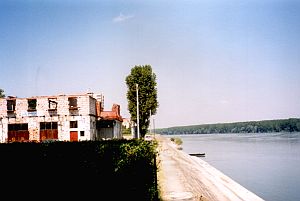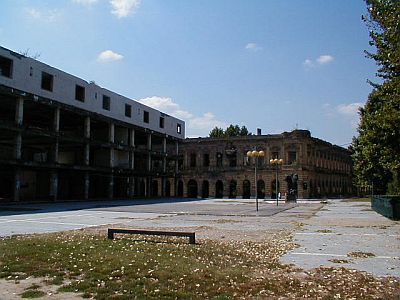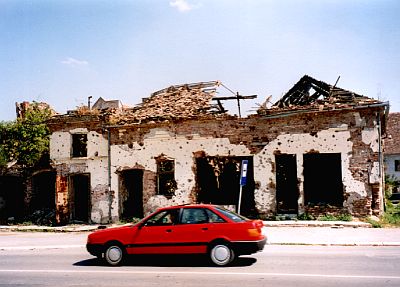Official Name
Vukovar. The name of the town derives from the small river Vuka, a small tributary flowing into the Danube in Vukovar. The name Vuka again might derive from Vucedol - a tribe settling in East Slavonia during the Bronze age. Centuries ago, there was a fortress called Vukovo. Another out-of-use name is Wolkovar.
Location

| ||
| Vukovar |
Vukovar stretches along the right (western) bank of the river Danube. The Danube marks the border to →Serbia. The area around Vukovar is called East Slavonia / Syrmia. Except for some marshland, it's a very fertile plain without any hills. The capital →Zagreb is around 225 km away - as the crow flies - to the west. Vukovar is Croatia's easternmost city so to say. Almost in the heart of the town, the small river Vuka flows into the Danube. The closest bigger city is →Osijek - the centre of East Slavonia - 20 km west of Vukovar.
Population
Some 30,000 (2001). One third of the citizens are Serbs, which still causes problem. More than 50 % are Croats, the rest other minorities.
Orientation
Vukovar faces the Danube river and is divided into two parts by the small river Vuka. North of Vukovar, large industrial complexes straddle the main road to Osijek. However, the industrial area was almost completely destroyed during the war. The main bus terminal can be found north of the rather hilly center of town. From the bus terminal, it's only 10 minutes on foot to the Danbue. When walking south along the main road from the bus terminal, one will first cross the bridge over the Vuka and than enter the centre of town. Righ behind the bridge on the left, there's the heavily destroyed, formerly beautiful Radnicki Dom. Vukovar is a rather small town, and so is the old town.
Beware: Large parts of the city underwent heavy mortar attacks during the war, destroying virtually every building. To rebuilt the entire city will take a lot of time. Hence, common sense regarding mines and UXO's (unexploded ordinances) is absolutely necessary.

| ||
| Vukovar at the Danube - and Serbia on the right |
History
Naturally, the history of Vukovar is quite similar to the history of nearby →Osijek. The Romans built first settlements and castles along the river Danube to protect their empire. During the 10th century, a small fortress called Vukovo was founded in present-day Vukovar. However, the name 'Vukovar' didn't appear before the 14th century. As with the rest of Croatia (see also →History of Croatia), Vukovar was occupied by the Ottoman empire for many centuries. In 1687, the Austrian Habsburg monarchy gained control over the area, letting Serbs and Croats settle along the Danube. After 1918, Vukovar became part of Croatia resp. Yugoslavia.
After Croatia declared independence, mounting tensions between radicalized Croats and Serbs in and around Vukovar developed into a full-scale war. According to various sources, it all started with a Serb dominated village refusing to hoist the Croatian national flag. Croatian authorities decided to send in a police squad, but it turned out to be an ambush. Some police officers were killed. According to other sources, already before this incident ethnic cleansing by the Croats had taken place around East Slavonia. Needless to say that declarations regarding the beginning of war are contradictory. But it's a fact that this incident marked the beginning of war. Soon, Vukovar's citizens found themselves besieged by the Serb-dominated JNA (Yugoslav National Army). The siege included daily heavy mortar shelling.An estimated 2,000 people found shelter in a hospital for three months. After that, the JNA managed to capture the town. According to the War Crime Tribunal in Den Haag, many civilians were massacred after the capture. Vukovar remained under Serbian control until 1995, before the UN administration took over. Following a mutual agreement, Vukovar was handed back to Croatia in 1998, but it's still under international observation to protect the Serb minority.
Comparable to →Mostar, Vukovar is a united town divided by an invisible frontier, which is defined by ethnicity. The frontier might be invisible, but it doesn't look like it's going to vanish in the near future.
Getting there / transportation
There's a railway connection, but there are no long-distance trains stopping in Vukovar. The best way to go is via →Osijek, which is only about 25 km away. Several buses a day run between Vukovar and Osijek. It takes less than one hour, the return fare is 37 Kuna. There are even direct buses from Germany to Vukovar. There's no border crossing with →Serbia in the vicinity, so it's necessary to go to the north or to the south first.
Once, Vukovar was the centre of the region, and so the Count of Eltz decided to erect a marvellous, two-storey palace in the heart of Vukovar. That was in the 18th century. Unfortunately, the palace fell victim to the war in 1991/2. All that was left were bullet-ridden façades (but as far as I had heard, the castle has been reconstructed). Furthermore, there's a famous Franciscan Monastery, which has been rebuilt after the war, too. Additionally, there are/were many beautiful baroque buildings in the centre of town.

| ||
| The square in front of the Radnicki Dom, once a hotel |
After the end of the Second World War, Vukovar developed into an important industrial centre. Especially in the suburbs north-west of town, namely Borovo, huge industrial complexes were erected. Among others, they produced almost all of the rubber and textiles used in Yugoslavia. The town also features an important harbour, which is still in use today.
Scars of the brutal war are omnipresent. Whereever you look, you will see marks left by mortars, guns and grenades - giving evidence for the long siege and street fights. The town is being rebuilt gradually. But when we visited in 2001, ten years after the siege, almost all buildings were in ruins (which we didn't expect...it was quite a shock).

| ||
| Turning back to everyday life!? |
But there are also many new or rebuilt apartment blocks and other buildings. Life is going on in Vukovar. Hopefully.
We didn't stay in Vukovar, but as far as I've heard, some hotels in town are back in business (one is called 'Lav', another one 'Dunav'). Since Osijek is near, it's also possible to stay there (see information on →Accommodation in Osijek) and visit Vukovar in a day trip
- www.vukovar.hr Official website of the town of Vukovar. Unfortunately in Croatian only.
- www.crucibleofwar.com/vukovar.htm Some information about the town itself and more or less neutral reports of eyewitnesses to the war. English.
- www.cosy.sbg.ac.at/~zzspri/travels Travelogue and background information about Vukovar. English.
- www.ypgd.org Website of the Youth Peace Group Danube - an NGO trying to help the youth bringing back normality. English and Croatian.
Do you have or do you know a good website about Vukovar? Don't hesitate, let me know! After checking it, I would love to add it to the link list. You can submit a link by using the →contact form. Note that commercial websites will be treated differently.
©2024 Europe-East.com

 Albania
Albania Croatia
Croatia